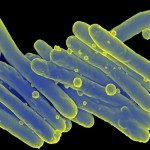Lien vers Pubmed [PMID] – 19876393
PLoS Pathog. 2009 Oct;5(10):e1000645
A critical feature of Mycobacterium tuberculosis, the causative agent of human tuberculosis (TB), is its ability to survive and multiply within macrophages, making these host cells an ideal niche for persisting microbes. Killing the intracellular tubercle bacilli is a key requirement for efficient tuberculosis treatment, yet identifying potent inhibitors has been hampered by labor-intensive techniques and lack of validated targets. Here, we present the development of a phenotypic cell-based assay that uses automated confocal fluorescence microscopy for high throughput screening of chemicals that interfere with the replication of M. tuberculosis within macrophages. Screening a library of 57,000 small molecules led to the identification of 135 active compounds with potent intracellular anti-mycobacterial efficacy and no host cell toxicity. Among these, the dinitrobenzamide derivatives (DNB) showed high activity against M. tuberculosis, including extensively drug resistant (XDR) strains. More importantly, we demonstrate that incubation of M. tuberculosis with DNB inhibited the formation of both lipoarabinomannan and arabinogalactan, attributable to the inhibition of decaprenyl-phospho-arabinose synthesis catalyzed by the decaprenyl-phosphoribose 2′ epimerase DprE1/DprE2. Inhibition of this new target will likely contribute to new therapeutic solutions against emerging XDR-TB. Beyond validating the high throughput/content screening approach, our results open new avenues for finding the next generation of antimicrobials.

